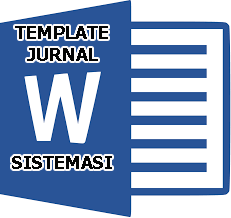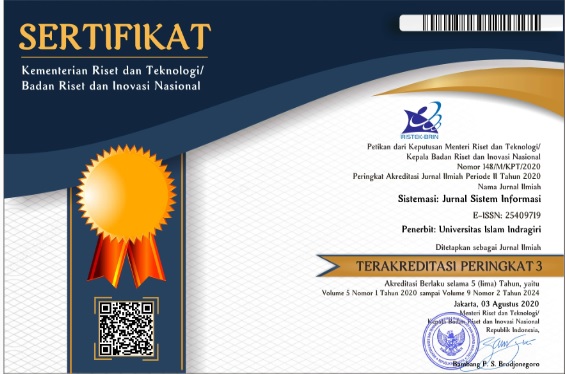Analysis of Internet Quality Improvement from HFC to FTTH in Housing X
Abstract
Keywords
Full Text:
PDFReferences
A. A. Tambunan and Lukman, "Analisis Perbandingan Quality of Service (QoS) pada Performa Bandwidth Jaringan dengan Metode Hierarchical Token Bucket (HTB) dan Per Connection Queue (PCQ)," Jurnal Teknologi Informasi, Vol. XV, No. 3, 2020.
S. Suherman et al., "Analysis of Electric Power Consumption in FTTH Network by Reducing Amount of Node HFC," Int. J. Innov. Sci. Res. Technol., Vol. 8, No. 5, pp. 3847-3853, May 2023. [Online]. Available: https://ijisrt.com/assets/upload/files/IJISRT23MAY2417.pdf
(Analisis konsumsi daya FTTH vs HFC)
A. Khalil et al., "Impact of HFC to FTTH Migration on Network Availability," J. Netw. Syst., Vol. 15, No. 2, pp. 45-60, 2023.
E. Wahyudi et al., "Power Budget Optimization in FTTH Networks for Urban Deployments," J. Lightwave Technol., Vol. 41, No. 5, pp. 1456-1465, 2023.
L. Rahmawati et al., "Performance Evaluation of FTTH in High-Density Environments," IEEE J. Opt. Commun. Netw., Vol. 15, No. 3, pp. 234-245, 2023.
R. Nugroho et al., "Latency Reduction in FTTH Networks Using Advanced Modulation Techniques," IEEE Photon. Technol. Lett., Vol. 35, No. 8, pp. 401-404, 2023.
E. Safrianti and W. T. Mukti, “FTTH Network Expansion Modeling and Link Budget for Housing Locations,” Int. J. Electr. Energy Power Syst. Eng., Vol. 2, No. 1, pp. 22–26, Feb. 2019, doi:10.31258/ijeepse.2.1.22-26.
S. Ridho, A. N. A. Yusuf, S. A. Andra, D. N. S. Sirin, and C. Apriono, “Fiber to the Home (FTTH) Network Design at Housing in Urban Areas,” J. Nas. Teknol. Elektro dan Teknol. Inform., Vol. 9, No. 1, , doi:10.22146/jnteti.v9i1.138.
H. Wibowo, A. Nugraha, and R. Kurniawan, “RTT and Packet Loss Evaluation on FTTH Networks using Ping and Traceroute,” Jurnal Teknik Telekomunikasi, Vol. 9, No. 1, pp. 12–20, 2022.
R. Nugroho, I. Suryadi, and D. Hidayat, “Evaluating QoS and MOS in FTTH Services with Latency and Jitter Variables,” IEEE Photonics Technology Letters, Vol. 35, No. 8, pp. 401–404, 2023.
F. F. Mubarok and T. A. Wibowo, “Integrasi Sistem Headend HFC pada Jaringan Fiber to the Home untuk Layanan TV Broadcast Analog,” *Jurnal Elektro dan Telekomunikasi Terapan*, Vol. 5, No. 1, 2018.
P. Wulandari, S. Soim, and M. Rose, “Monitoring dan Analisis QoS (Quality of Service) Jaringan Internet pada Gedung KPA Politeknik Negeri Sriwijaya dengan Metode Drive Test,” *Prosiding SNATIF ke-4 Tahun 2017. [Online]. Available: https://media.neliti.com/media/publications/174268-ID-monitoring-dan-analisis-qos-quality-of-s.pdf
P. R. Utami, “Analisis Perbandingan Quality of Service Jaringan Internet berbasis Wireless pada Layanan Internet Service Provider (ISP) Indihome dan First Media,” *Jurnal Ilmiah Teknologi dan Rekayasa*, Vol. 25, No. 2, 2020.
ARRIS Enterprises, "HFC Transformation to FTTP: The Role of RFOG, PON, and DOCSIS 3.1," Whitepaper,2023. [Online]. Available: https://www.commscope.com/globalassets/digizuite/1641-arris-hfctofttp-whitepaper-final.pdf.
N. Sari et al., "Comparative Study of HFC and FTTH Reliability in Tropical Climates," IEEE Trans. Reliab., Vol. 72, No. 2, pp. 789-798, 2023.
C. Silvia, K. S. Syahrani, and A. Adriansyah, “Analisis Pengujian Quality of Service Provider 4G LTE pada Smartphone Android di Teknik Elektro Politeknik Negeri Sriwijaya,” TELISKA J. Tekn. Elektro Polsri, Vol. 17, No. 1, Mar. 2024, doi:10.5281/zenodo.10878572.
D. Kusuma et al., "Fiber Optic Cable Attenuation Analysis for FTTH Migration," IEEE Trans. Instrum. Meas., Vol. 72, pp. 1-10, 2023. (Analisis Redaman Kabel Serat Optik dalam Migrasi)
F. Gunawan et al., "QoS Improvement in Hybrid HFC-FTTH Networks using Dynamic Bandwidth Allocation," IEEE Trans. Netw. Serv. Manag., Vol. 20, No. 1, pp. 567-578, 2023.
T. Suryadi et al., "Optimization of FTTH Deployment in Urban Residential Areas," IEEE Access, Vol. 11, pp. 12345-12356, 2023.
V. Ratkoceri, "Techno-Economic Analysis of HFC and FTTH Upgrades," J. Telecommun., Vol. 12, No. 4, pp. 89-102, 2023.
F. Anissabilla and R. Kusumarani, “Analisis dan Evaluasi Kinerja Jaringan Internet berdasarkan Quality of Service (QoS),” in *Proc. Seminar Nasional SainTek*, Tangerang Selatan, Feb. 2025, pp. 12–20. doi:10.36040/saintek.v2i1.5128.
DOI: https://doi.org/10.32520/stmsi.v14i5.5222
Article Metrics
Abstract view : 864 timesPDF - 68 times
Refbacks
- There are currently no refbacks.

This work is licensed under a Creative Commons Attribution-ShareAlike 4.0 International License.









